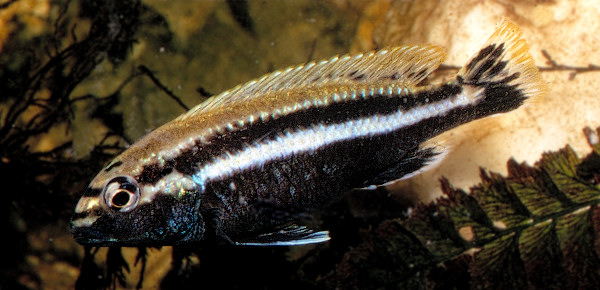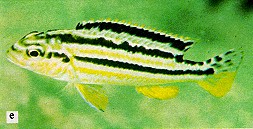

Above: A male Melanochromis auratus, aquarium photo © M.K. Oliver. This beautiful cichlid was initially named Chromis auratus, more recently Pseudotropheus auratus, and was among the earliest species in the Mbuna group to be known to science when it was first described by Boulenger (1897) from a single specimen collected at Monkey Bay by a Mr. G.H. Pigott — only Cynotilapia afra and Pseudotropheus williamsi were named earlier (Günther, 1894).
In the small photo at left, compare the appearance of the female's lower black stripe, and the
distribution of black markings in the caudal (tail) fin, with the same features on its recently described close relative, Melanochromis dialeptos. M. auratus has a smoother black stripe, while that of M. dialeptos is more strongly serrated. The caudal spots of M. auratus are concentrated in the upper half of the fin, whereas they are found throughout the fin in M. dialeptos.

Melanochromis auratus, a young female
photographed underwater at Monkey Bay,
Malawi. From Plate 9e of Ribbink et al.
(1983); reproduced by permission of the
Zoological Society of Southern Africa.M. auratus has the typical coloration of the genus Melanochromis. That is to say, (1) the dominant feature of the color pattern in both sexes is horizontal stripes (instead of the vertical bars that are typical of most other Mbuna); and (2) mature males have the "negative" pattern of females and immature fishes (compare the photos of the male and female, noting that the male's white stripes are located where the female's black ones are found).
Although extremely colorful and widely available, M. auratus is not a good choice for the novice at keeping Malawi cichlids. Males are extremely aggressive and the dominant one will try to kill any other males of its species, as well as females if they are not in spawning condition or are not provided with adequate hiding places. Only one male should be kept per aquarium, and at least three or, preferably, four or five females provided.
To be kept successfully, at least a 55 gallon aquarium well provided with rocks or other cover is advisable. Other species of Melanochromis should not be maintained in the same tank or they are apt to hybridize, which is highly undesirable. Addition of some dither fish, such as Australian rainbows, may be helpful as a distraction to the male from constantly bedeviling a particular fish. A nicely illustrated article by Jennifer Wilkinson is available on keeping and breeding M. auratus.
Because Melanochromis auratus is common, widely distributed in Lake Malawi, and easily identified, this species has been a subject of numerous biological research publications. Among them are the classic studies by Fryer (1959a) and Ribbink et al. (1983) on general ecology; studies of dominance hierarchies by Andries and Nelissen (1988, 1989a,b, 1990), Nelissen (1985a,b, 1986, 1992), and Nelissen and Andries (1988, 1989); a report by Hale (1997) on feeding angle; Hale et al. (1998) on exceptions to sexually dimorphic coloration (two female individuals in the laboratory were found with typical male colors); Hert (1993) on habitat time sharing; Kawai et al. (2001) on anal fin spots and mating behavior; Kellogg et al. (1995) on reduced levels of mtDNA polymorphism; Kornfield and Parker (1997) on molecular phylogenetics; Kuroda et al. (2003) on chemokine proteins and receptors; Markert (1998) on population structure and phylogenetic history; Markert et al. (1999) on population genetics and within-lake biogeography; Rusche (1983) on the influence of environmental evaluation by the fish on behavior; K.W. Thompson (1981) on karyotypes; and others.

| Last Update: 8 July 2011
Web Author: M. K. Oliver, Ph.D. Copyright © 1997-2021 by M. K. Oliver, Ph.D. - ALL RIGHTS RESERVED |